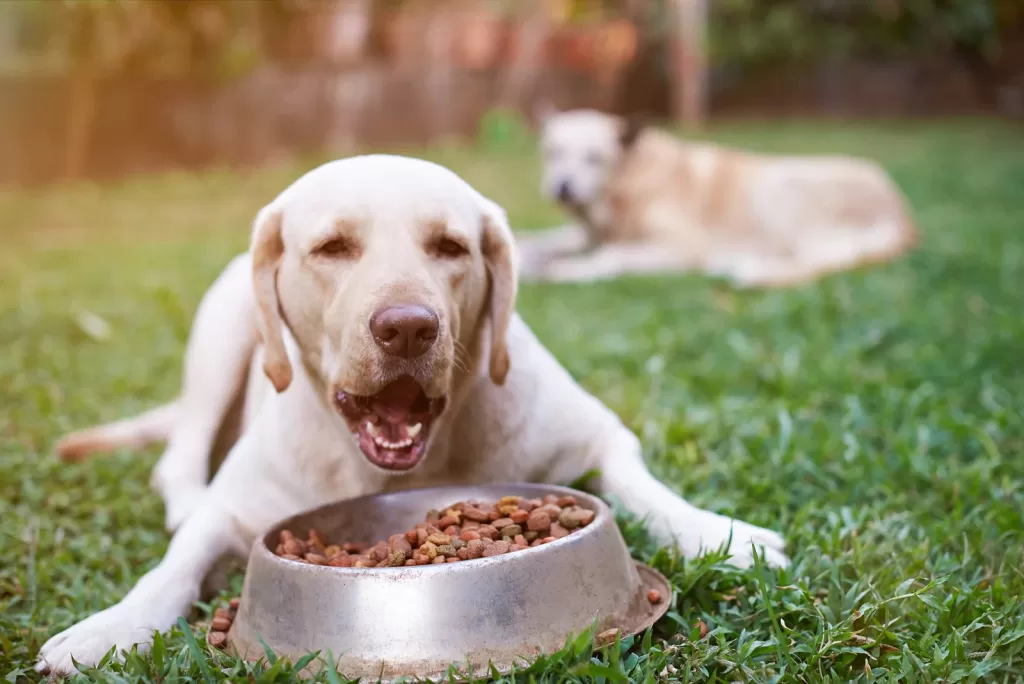Soft Dog Food for Senior Dogs? Yes, As your dog enters their golden years, So-called your aged dog, you might notice them turning up their nose at tiny foods like small kibbles they once devoured or struggling to chew their favorite treats. Its time to look for change in their diet.
Table of Contents
So, what happens basically at this age for dogs? Aging brings changes—slower metabolisms, dental issues, and shifting nutritional needs—that demand a thoughtful approach to mealtime. For senior dog owners, choosing the right diet isn’t just about taste; it’s about supporting longevity, comfort, and vitality.

Take Roxy, my relative’s 12-year-old Doberman. Despite her age, she’s spry and alert—no small feat for a large breed! Her secret? A carefully curated soft food diet that addresses her evolving needs.
Why Senior Dogs Need Special Diets
This question was very common in most of the dog owners or pet parents, they might have felt like “am well versed in knowing what to feed my dog and its been almost a decade am feeding my dog and what changes now?” But the problem is you never know what changes are being incorporated in your being a 10 year old senior dog. Lets dive deep and understand further.
The Aging Canine Body: What Changes?
As dogs age, their bodies undergo shifts similar to humans. Dental health declines (25% of dogs over 12 have tooth loss), metabolism slows by up to 30%, and digestion becomes less efficient.
Organs like kidneys and liver work harder, requiring diets lower in phosphorus and higher in easily digestible proteins.
Roxy’s vet once noted that her reluctance to eat kibble wasn’t pickiness—it was due to worn molars. Switching to soft food eliminated her discomfort and reignited her appetite.
Age-Related Internal Changes in Dogs and Dietary Adjustments
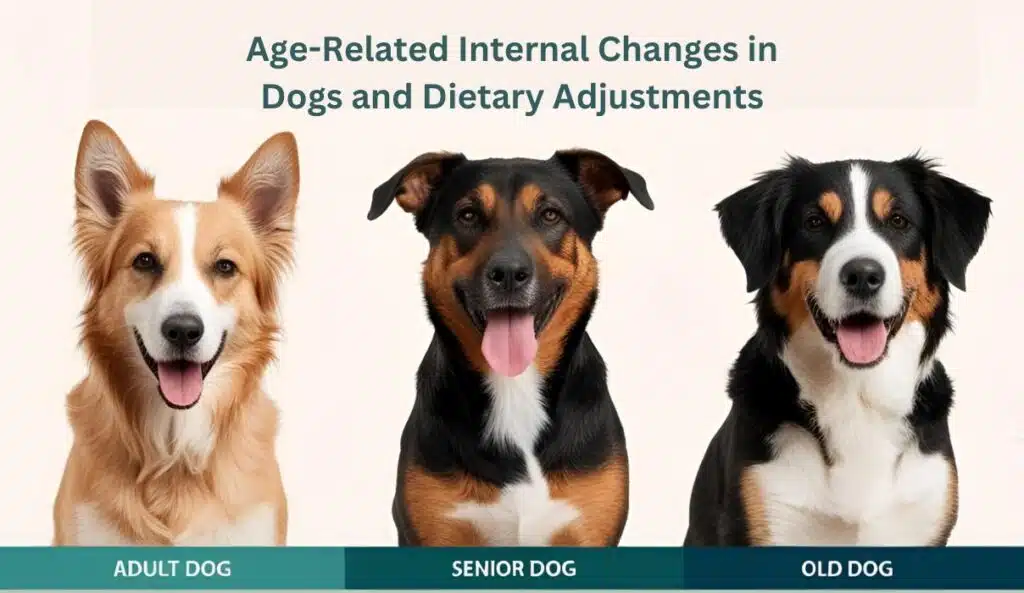
6–9 Years (Senior)
Internal Changes:
- Muscle Atrophy: Sarcopenia begins; protein synthesis slows.
- Renal Decline: Reduced kidney function; risk of CKD.
- Dental Issues: Plaque buildup, tooth loss.
- Digestive Slowing: Lower enzyme production; fiber needs increase.
Dietary Adjustments:
- High-Quality Protein: 25–28% easily digestible sources (egg, lamb).
- Low Phosphorus/Sodium: <0.5% phosphorus, <0.3% sodium.
- Softer Textures: Wet food or soaked kibble for dental comfort.
- Added Fiber: 3–5% fiber (pumpkin, beet pulp) for gut health.
9–12 Years (Geriatric)
Internal Changes:
- Organ Decline: Significant kidney/liver/heart strain.
- Cognitive Dysfunction: Brain aging affects appetite/behavior.
- Reduced Immunity: Higher infection risk.
- Hydration Issues: Decreased thirst drive.
Dietary Adjustments:
- Easy Digestion: Hydrolyzed proteins or prescription diets.
- Omega-3s: EPA/DHA (1.5% fat) for brain/joint support.
- Palatability: Warm, aromatic meals to stimulate appetite.
- Moisture-Rich Diets: >70% water content (canned/raw).
| Age Range | Key Internal Changes | Dietary Focus |
|---|---|---|
| 1–3 Years | Metabolism stabilizes; peak muscle mass. | High protein, moderate calories, dental care. |
| 3–6 Years | Metabolic slowdown; joint wear. | Calorie control, joint support, antioxidants. |
| 6–9 Years | Muscle loss; kidney/dental decline. | Easily digestible protein, low phosphorus. |
| 9–12 Years | Organ/cognitive decline; hydration issues. | Moisture-rich, omega-3s, palatable meals. |
So, I think this gives you a clear picture what happens to a dog body when he/she starts ageing, I have ignored the metabolism of Puppy and Adult dogs because this topic is more about senior dogs.
Key Nutritional Needs for Senior Dogs
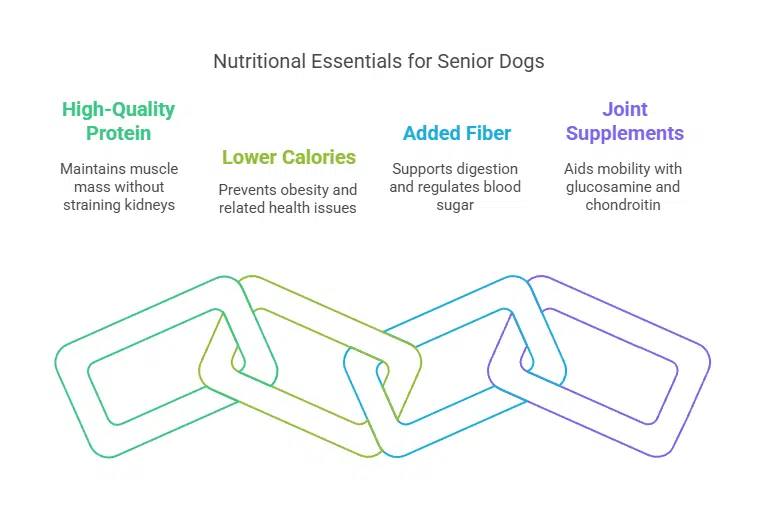
- High-Quality Protein: Maintains muscle mass without straining kidneys. Look for sources like chicken, turkey, or salmon.
- Lower Calories: Prevents obesity, which exacerbates arthritis and heart disease.
- Added Fiber: Supports digestion and regulates blood sugar.
- Joint Supplements: Glucosamine and chondroitin aid mobility.
| Nutrient | Adult Dogs (7–10 yrs) | Senior Dogs (10+ yrs) |
|---|---|---|
| Protein | 18–25% | 25–30% |
| Fat | 10–15% | 8–12% |
| Fiber | 2–4% | 4–6% |
| Phosphorus | 0.5–1.0% | 0.3–0.6% |
Adult vs. Senior Dog Nutritional Needs | Source: Association of American Feed Control Officials (AAFCO)
Benefits of Soft Dog Food for Senior Dogs
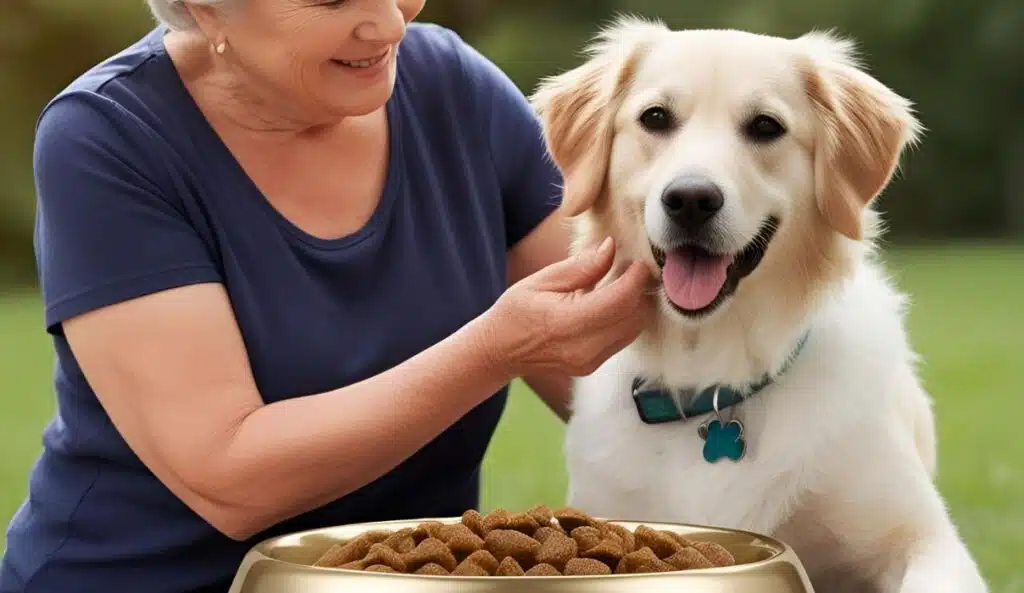
When I fed my dog, Rocky the German shepherd, a very high protein food like chicken liver, mutton chops and other commercial high protein food, he gained good weight and height.
Once he got the good height and proper weight, its time to look for changes in diet and now its time for good and appropriate food. That is where the benefit of Soft Dog food for older dogs comes into the picture.
Easier Chewing and Digestion
Soft food’s moisture-rich texture is gentler on worn teeth and sensitive gums. A study by the WSAVA found that 60% of senior dogs prefer wet or softened meals over dry kibble. For Roxy, switching to soft food meant fewer vet visits for dental pain and more enthusiasm at mealtime.
Enhanced Hydration
Many senior dogs drink less water, increasing dehydration risks. Soft foods contain 70–80% moisture, supporting kidney function and urinary health.
Higher Palatability
Soft foods often have stronger aromas and flavors, which can stimulate appetite in picky eaters
Customizable for Health Conditions
Brands like Hill’s Prescription Diet and Royal Canin offer formulas tailored to ailments like kidney disease or diabetes. Always consult your vet before choosing a therapeutic diet.
How to Choose the Best Soft Food for Your Senior Dog
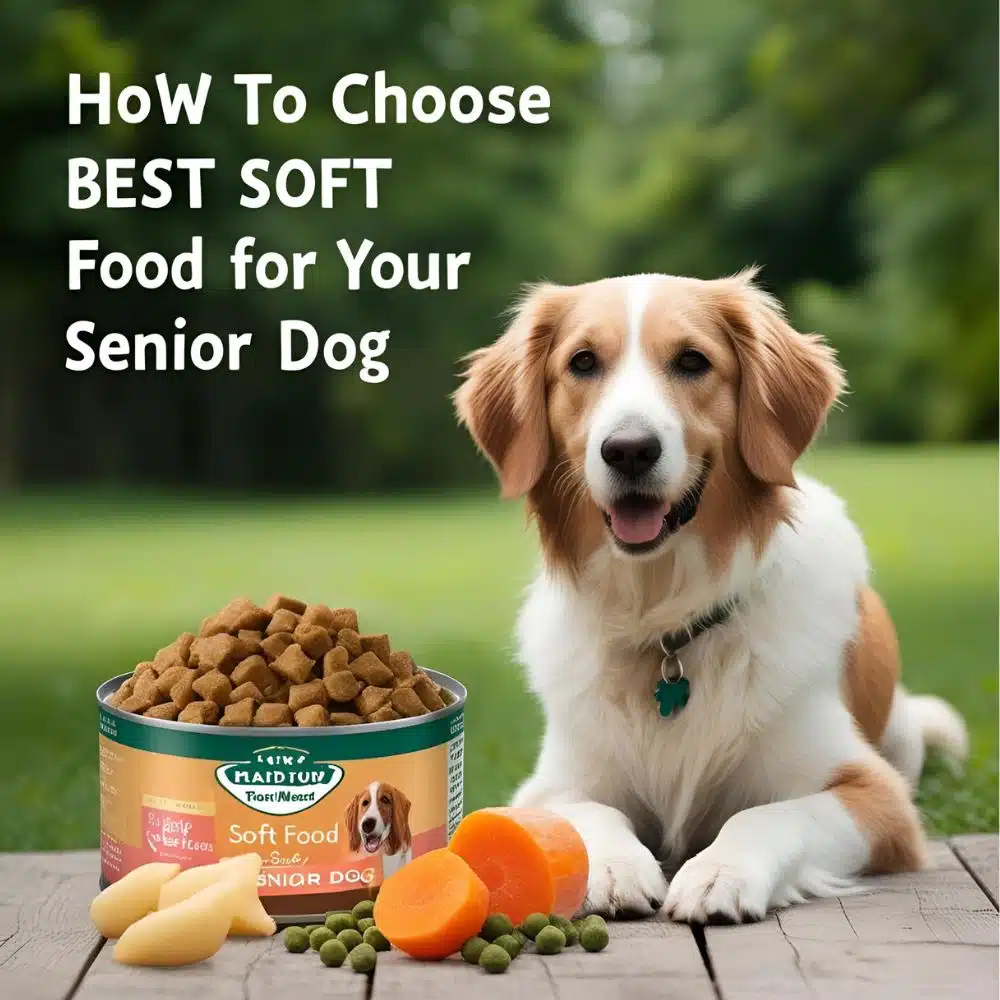
Soft dog food includes a variety of options such as canned food, moist or semi-moist foods, sous-vide meals, and dehydrated or freeze-dried foods. These options are designed to be gentle on the teeth and gums, making them ideal for senior dogs with dental issues.
Ingredient Red Flags to Avoid
- Fillers: Corn, soy, and by-products offer little nutritional value.
- Artificial Additives: Colors, flavors, or preservatives like BHA/BHT.
- Excessive Sodium: Worsens heart and kidney issues.
Top-Rated Soft Food Brands
| Brand | Protein Source | Key Features | Price Range (per lb) |
|---|---|---|---|
| Blue Buffalo Homestyle Recipe | Chicken | Grain-free, omega-3s for joints | 3.50–3.50–4.00 |
| Purina Pro Plan Bright Mind | Turkey | Enhanced with botanical oils for cognition | 2.80–2.80–3.20 |
| The Farmer’s Dog (Subscription) | Beef | Customized meals, human-grade ingredients | 6.00–6.00–8.00 |
Homemade Soft Food Options
For owners preferring DIY meals, recipes with lean ground meat, pumpkin, and quinoa are nutrient-dense. However, consult a veterinary nutritionist to avoid imbalances—BalanceIT offers free recipe templates.
Transitioning to Soft Food: A Step-by-Step Guide
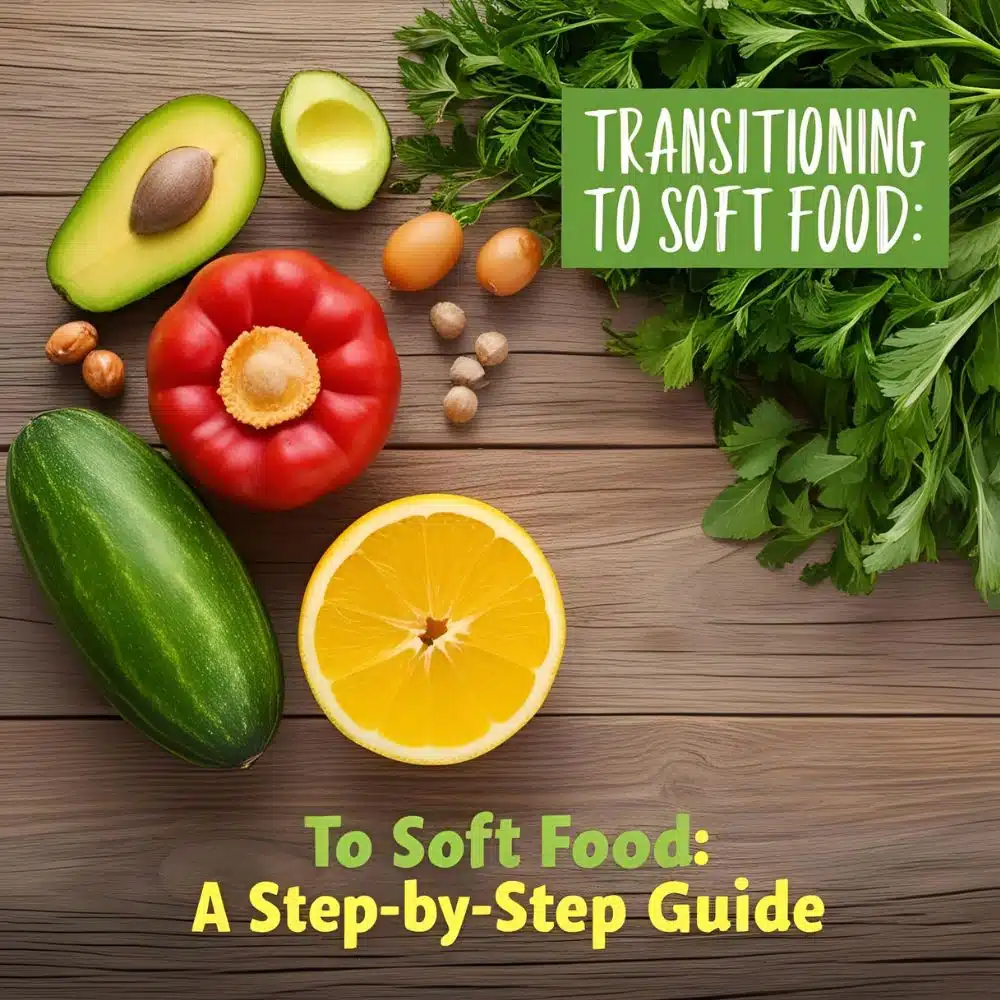
Gradual Introduction is Key
Mix 25% soft food with 75% kibble for 3 days, increasing gradually over 7–10 days. Roxy’s transition took 10 days, with her vet monitoring her weight and digestion.
Troubleshooting Picky Eaters
- Warm the food slightly to enhance aroma.
- Add low-sodium bone broth for flavor.
- Try rotational feeding (alternating proteins/textures).
Addressing Common Health Issues Through Diet
Addressing common health issues in senior dogs through diet involves tailoring their nutrition to meet specific needs related to age-related conditions. Here’s how diet can help manage some of the most prevalent health issues in senior dogs:
Kidney Disease
Low-phosphorus, low-sodium diets reduce kidney strain. Brands like Hill’s k/d are vet-recommended.
Arthritis
Omega-3 fatty acids in fish-based soft foods (e.g., Weruva Paw Lickin’ Chicken) combat inflammation.
Cognitive Decline
Antioxidant-rich foods with vitamins E and C support brain health. Roxy’s diet includes blueberries and spinach blended into her meals.
Final Thoughts
Choosing soft dog food for your senior pet isn’t just about easing meal prep—it’s a proactive step toward nurturing their health and happiness.
From Roxy’s renewed energy to the science-backed benefits of moisture-rich diets, the evidence is clear: aging dogs thrive when their meals align with their changing needs.

